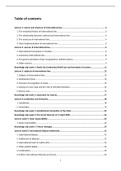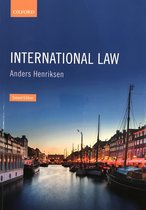Table of contents
Lecture 1: nature and structure of international law.........................................................................3
1. The evolution/history of international law.....................................................................................3
2. The relationship between national and international law..............................................................4
3. The structure of international law..................................................................................................4
4. (Non) Implementation of international law....................................................................................5
Lecture 2: sources of international law..............................................................................................6
1. International Convention or Treaties..............................................................................................6
2. Customary international law..........................................................................................................8
3. The general principles of law recognized by civilized nations.........................................................9
4. Other sources.................................................................................................................................9
Knowledge clip week 2: North Sea Continental Shelf Case and formation of custom......................11
Lecture 3: subjects of international law...........................................................................................12
1. Subjects of international law........................................................................................................12
2. Statehood criteria.........................................................................................................................13
3. Theories of recognition of states..................................................................................................13
4. Arising of a new state and the role of self-determination............................................................14
5. Kosovo case..................................................................................................................................15
Knowledge clip week 3: reparation for injuries................................................................................17
Lecture 4: jurisdiction and immunity...............................................................................................18
1. Jurisdiction....................................................................................................................................18
2. Immunities....................................................................................................................................19
Knowledge clip week 4: jurisdictional immunities of the State........................................................22
Knowledge clip week 4: The Arrest Warrant of 11 April 2000..........................................................24
Lecture week 5: State responsibility................................................................................................25
1. State responsibility.......................................................................................................................25
Knowledge clip week 5: Tehran Hostages........................................................................................29
Lecture week 6: international dispute settlement...........................................................................31
1. International dispute....................................................................................................................31
2. Settlement of disputes..................................................................................................................31
3. International Court of Justice (ICJ)................................................................................................31
4. Other judicial bodies.....................................................................................................................33
4.1 Arbitration..................................................................................................................................33
4.2 Other international tribunals and courts....................................................................................34
1
,Knowledge clip week 6: Advisory Opinion on the Legality of the Use by a State of Nuclear Weapons
in Armed Conflict.............................................................................................................................35
Lecture 7: the use of force...............................................................................................................37
1. UN Charter, Article 2(4)................................................................................................................37
Knowledge clip week 7: Nicaragua Case..........................................................................................40
2
, Lecture 1: nature and structure of international law
International law regulates relationships between states. We are affected by the rules that states
adopt with each other, for example the distribution of vaccines. Public international law contains
rules which govern the relations between states (inter-State relationships). Private international law
governs the relations between persons of different nationalities (trans-national private relationships).
Every state is equal but in practice, that’s not always the case. Every state is bound by international
law through consent.
1. The evolution/history of international law
Pre-Greek civilisations: before 2100 B.C. treaty between Lagash and Umma of Mesoptoamia to
organize a dispute resolution mechanism through arbitration, solemn oath for observance (plechtige
eed voor naleving).
Ancient Greek and Roman times: origin of certain principles and customs (gebruiken), for example
peace agreements, treatment of foreigners (there were a lot of foreigners coming to the different
cities).
Colonialism (15th century onwards): the acquisition of territories, sovereignty, freedom of high seas
etc. The Spanish, French, British and Dutch played a big role in the colonialism. There were a lot of
international law scholars who participated in the colonialism.
Catholic church: international institutions (1474: von Hagenbach trial, the first criminal trial).
End of 16th century: Pope’s gradual loss of power. This caused the modern birth of international law.
17th century: birth of modern ‘international community’. Important is the Peace of Westphalia: from
this moment on, the state becomes the unquestionable source of authority. There is a person or a
identity who can speak in one voice on behalf of the state. So, from this moment on, we had states,
the states became object of international law and the ability of states to excerpt this authority and
therefore engage in agreements with other states.
19th century: positivism vs. natural law. Positivism: international law is what the written rules are and
what agreements between states exist. Naturalism: we have certain rights and obligations without
having rules in that field. It comes from the power of God and the nature. Particularly, the western
world follows the positivism: a state would be only bound by the rules that it consented to. From
1865 onwards we’ve seen an emergence of international institutions that set up rules of
international law in writing.
Interwar period (20th century): creating of the League of Nations (predecessor of the United
Nations). A lot of important rules came from the League of Nations, for example that states should
not use force against each other.
After the First and Second World Wars: since this period we have the international criminal law but
also a lot of tribunals (Nuremberg and Tokyo tribunals). It has led to the development of
international law.
Decolonisation: States expressed their desire to become an independent state with that the right of
self-determination, what was possible because of international law.
3
, Globalisation (1989, fall of the Berlin wall): it allowed states to develop more rules in the fields in
international law and we see the rise of global governance and the ideas to regulate issues related to
trades, human rights etc.
9/11 (21st century): the rise of terrorism
Populism: an upcoming problem and a possible attack on multinational organizations and certain
initiatives and could bring back nationalism and create an attack on certain ideals and ideas of
international law.
2. The relationship between national and international law
The main difference is that domestic law regulates the relationship between the state and citizens
but also how citizens can interact with each other (e.g. marriage). International law, on the other
hand, regulates the relationship between states who are equal to each other. In case there is a
dispute, they need to act through international law.
Another difference is that in international law there is no police force, a parliament or a authority, in
contrast to national law.
The relationship between domestic law and international law is dependant from the approach of
countries to international law.
Monism: there is a single and coherent legal system which includes national and international law.
International law is thus directly applicable in the national legal system.
Dualism: there are two separate legal systems that operate independently. International law only
has effect when it has been adopted in national law.
Pluralism: relationship between the two systems is more complex and diverse. A state can be more
monist when it comes to certain rules, but it can be more dualist when it comes to other rules or
subjects. At times, a state can be more monist or dualist or have both approaches.
3. The structure of international law
There are two key notions that explain why we have international law:
- Coexistence: air travel, trade, use of the sea, creation of states, telecommunications. We
have one planet so we coexist. We need to regulate things because of our existence.
- Cooperation: human rights, international crimes, protection of the environment, prohibition
on the use of force. Cooperation gives a lot of benefits to states, for example the possibility
of having foreign food in your state. It is not necessary, but it gives benefits.
There are two key notions that explain how international law works:
1. Sovereignty: states have supreme power over their territory and may not be subject to the
jurisdiction of other states. Each state has one formal vote which counts equally. It doesn’t
matter how big the state is: each vote counts equally.
2. Consent: states must consent to be bound by international law. If they don’t consent to it,
they are also not bound by international law.
4





